In our industry, quality certifications are tools especially recognised and sought-after by the most quality-conscious companies, be they businesses coating their products in-house or contractors. The most prestigious international quality marks are QUALICOAT
for aluminium coatings and QUALISTEELCOAT
for steel coatings. The former was created in 1986, when a number of national associations, including the coaters of architectural components made of aluminium and its alloys, founded a structured organisation capable of establishing rules and procedures to increase and standardise quality levels throughout Europe. In recent decades, QUALICOAT has played a key role in ensuring the quality of aluminium parts used in architecture, involving not only applicators but also various stakeholders in the aluminium industry, suppliers of coating materials, and manufacturers of surface treatment chemicals. Similarly, in 2006, the steel coating industry felt the need to set up a European organisation with the same characteristics to guarantee the quality of liquid and powder-coated steel: QUALISTEELCOAT was thus created to promote the dissemination of culture on metal corrosion protection in different atmospheric environments. The first Italian company to have obtained and maintained this certification has been Pintarelli Verniciature Srl since 2013. Pintarelli Verniciature Srl specialises in contract powder coating of metal components for several different sectors, particularly architecture, air conditioning, and furniture. Alessandro Pintarelli, the founder of this company based in Lavis (Trento, Italy) together with his sister Tiziana, explains: “Together with the QUALICOAT certification obtained in 2018 and our Qualicoat Class 3 approvals with paint suppliers AkzoNobel and TIGER Drylac®, this gives us a competitive edge over our competitors and is highly appreciated by companies requiring coatings with high corrosion protection properties, particularly on components that have to travel long distances to destinations all over the world.”
Pintarelli Verniciature is a well-known player in the coating industry: always attentive to market evolutions and the development of new solutions, it has been collaborating with the Corrosion Control Laboratory of the Department of Industrial Engineering at the University of Trento for over thirty years, where it carries out application tests and feasibility analyses, as well as initiating specific R&D projects of common interest. “To maintain the high level of quality required by these certification procedures, we need the best technology on the market. The latest innovation we have integrated into our coating line is the second-generation Dynamic Contour Detection system developed by Gema Europe Srl. Thanks to its new laser scanners, it ensures greater coating precision, increases transfer efficiency and finishing quality, and eliminates any risk of error due to programming parameters.”
Pintarelli Verniciature: a powder coating pioneer
Pintarelli Verniciature was founded in 1987 to provide a local customer with a liquid painting service, soon joined by powder coating, which was still uncommon at the time. “Our company has always had a pioneering vocation,” confirms Alessandro Pintarelli. “This has led us to anticipate market demands on many occasions, also supported by the collaboration with the Corrosion Control Laboratory of the University of Trento, started in 1993.” To keep abreast of this rapidly changing industry, the company has gradually integrated more and more state-of-the-art plants and equipment, to such an extent that the whole history of Pintarelli Verniciature has been proceeding hand in hand with the progress of powder coating technology over the years. “In 1999,” says its owner, “we replaced our manual powder coating booth in galvanised steel with one made of dielectric plastics, which allowed us to change colour more quickly by eliminating the problem of residual electrostatic fields. That enabled us to expand the range of powder RAL colours we could offer our customers. Between 2002 and 2003, the plant was fully upgraded to improve performance control and increase production flexibility in terms of size, processable parts, and colour range: the drying and curing ovens were replaced, and a new four-stage pre-treatment tunnel was installed.”
Between 2008 and 2012, the company initiated a research project called “Duplex: hot-dip galvanised steel coatability” in collaboration with the University of Trento’s Corrosion Control Laboratory and a well-known hot-dip galvanising company based in the area. “The goal,” recalls Pintarelli, “was to verify the influence of the hot-dip galvanising process on the coatability of steel components.” Further applied research projects were conducted in the following years, between 2014 and 2023, focusing on different topics such as coating durability, the influence of coatings on the environment, and the characterisation of low-e coatings. 2013 marked a significant turning point in the growth of Pintarelli Verniciature, as it moved to a new 11,000 m2 headquarters to accommodate a new, fully automated coating plant and a new R&D division. “During the same period, as a result of our constant research studies on the corrosion protection of steel, we were among the first companies to obtain QUALISTEELCOAT certification. In 2017, our 30th anniversary year, we integrated a new pre-treatment plant for aluminium in compliance with the QUALICOAT Product Certification we obtained in 2018.
Two years later, we focused on our application equipment: we transformed our plant according to Industry 4.0 parameters, installed Gema’s innovative powder feeding system Smart Inline Technology to replace its Venturi pumps to improve film distension and application quality, and replaced its powder centre with Gema’s new OptiCenter OC07 unit to achieve optimal and consistent coating results. Finally, in 2022, we installed a new fully automated stainless steel pre-treatment tunnel connected to our central management system; intending to completely automate our factory, we also automated the paint warehouse using a MODULAR system. That is how, although we started out as a simple coating contractor tied to one local customer, we have now achieved an enviable and diversified customer portfolio in different sectors and geographic areas, including Switzerland and Austria.”
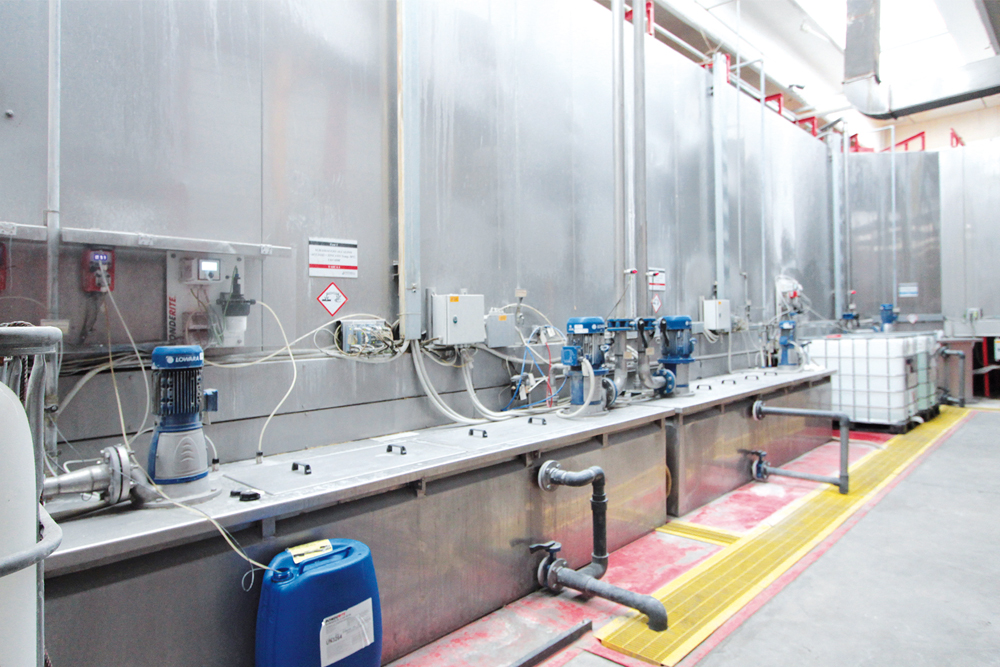 The pre-treatment tunnel. © ipcm
The pre-treatment tunnel. © ipcmBeyond coating: from the Kanban system to assembly
Thanks to the improvement of its logistics and warehousing operations and the integration of an assembly department, Pintarelli Verniciature has developed into a full-fledged external production department for its customer companies, capable of providing an all-round service that complements powder coating. “We directly purchase the components that must be mounted on the coated parts. Especially with architectural parts, we can thus place them in their assembly kits and ship them directly to the construction sites. This has a double value for us: we reduce our delivery times by providing a service that the market seemed to need for a long time and we further meet our customers’ needs with an added-value operation.”
To manage the purchase of steel and aluminium components and their storage in its warehouse, Pintarelli Verniciature adopted the Kanban system. “Based on bar codes, it enables the warehouse manager to have full control over the level of supplies. Our warehouse is so well structured that it even acts as a logistics hub for some of our customers, storing their components and informing them when the stock starts to run low via data sharing software.”
Quality assurance certification protocols
In Pintarelli Verniciature’s production department, the monorail conveyor first takes the parts to the pre-treatment tunnel, which performs the following stages: degreasing, two rinses with mains water, deoxidation of aluminium and galvanised steel parts if required and further rinse, two rinses with demineralised water, and application of Henkel’s Bonderite® APNR (Adhesion Promoter No Rinse). Once the parts are dried, the powder application phase can begin, followed by oven-curing with a temperature of up to 200 °C and unloading. “The protocols for obtaining and maintaining our certifications entail frequent checks of the values both of the baths and of samples by designated bodies such as Qualital. Thanks to the high quality of our pre-treatment and powder application phases, we can achieve corrosion class C5H even with Sendzimir sheet steel, which we paint in three coats, i.e. two layers of primer and one of top coat. We are the only company to provide this service, in response to a specific request from some customers needing to achieve this corrosion protection class with this type of sheet metal.”
For Pintarelli Verniciature, one of its team’s most delicate jobs is making customers aware of the crucial role of surface quality: “In our workshops, we try to make our stakeholders aware of the importance of meeting minimum product requirements as an objective involving the entire supply chain, in order to achieve the expected corrosion and durability properties, as defined by law and by the technical specifications of the QUALISTEELCOAT and QUALICOAT certifications. We also noticed that whereas until recently, very few clients requested this type of certification and it was always our team that brought it up first, today, especially in the field of architecture, a quality-oriented culture is spreading that also translates into the demand for these two certifications. And we are already prepared to meet it, thanks to the continuous updating of our systems, including the recent integration of Dynamic Contour Detection.”
Dynamic Contour Detection: key benefits
“This technology,” illustrates Gianluigi Baroni, the Sales Manager of Gema Europe Srl, “uses laser scanners to detect the shapes of complex parts. The dynamic contour detection process takes place through two stages: reading and application. Installed at the booth’s entrance, the laser scanners work in two-dimensional mode and provide a digital image of the contour of the application area. This data, combined with precise speed tracking via a dedicated encoder, generates an exact three-dimensional contour of the object, immediately sent to the MagicControl 4.0 device. Each individual gun is positioned and activated automatically and dynamically based on this precise digital reproduction, moving along an autonomous horizontal axis independent of the others.” Thanks to multi-angle technology, the scanners can detect the contours of the thinnest workpieces and the most complex shapes.
“We also changed the guns’ layout inside the booth,” emphasises Pintarelli Verniciature’s Production Manager, Paolo Ferrero, “significantly reducing the distance between one gun and the other. This gave us greater control over the thickness and quantity of powder dispensed by each nozzle and improved our degree of quality and application efficiency thanks to higher dispensing consistency and, therefore, better film distension. Greater application control also means significant powder savings. Although this new system has only recently been integrated, one of its advantages is already clear: out of the three operators per shift in charge of pre- and post-finishing activities, one has already been transferred and assigned to other functions. That means we have assigned this people to logistics related activities, which, as mentioned, are becoming increasingly relevant.”
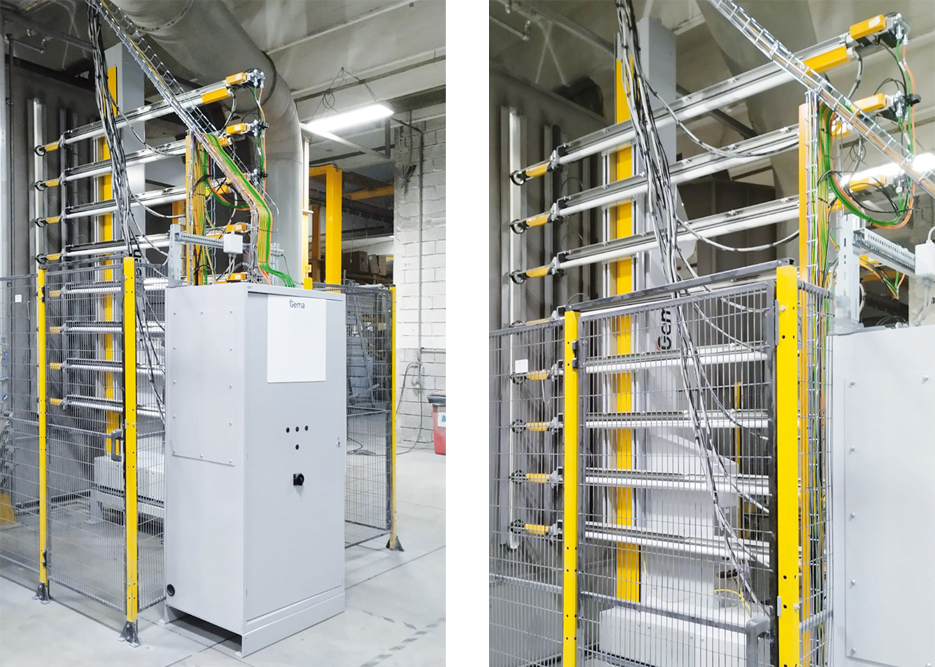 Each individual gun is positioned and activated automatically and dynamically based on the precise digital reproduction of the piece, moving along an autonomous horizontal axis independent of the others. © Gema
Each individual gun is positioned and activated automatically and dynamically based on the precise digital reproduction of the piece, moving along an autonomous horizontal axis independent of the others. © Gema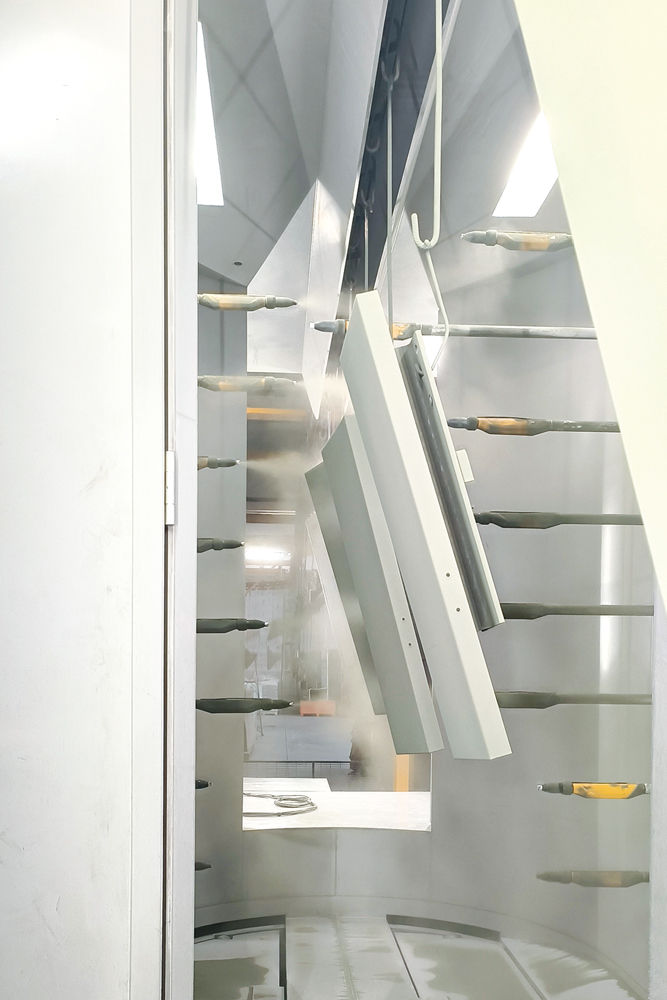 The inside of the booth. © Gema
The inside of the booth. © GemaA change of mindset
“In addition to the concrete advantages brought by this new system,” adds Ferrero, “we are gradually changing the mindset of our operators, who were used to working by holding the powder application gun in their hands to carry out pre- and post-finishing operations. Now, on the other hand, they have to learn how to use another type of device, the Coatmaster® Flex, intended exclusively for measuring coating thicknesses and, if there are any defects, adjust the operating parameters on the MagicControl 4.0 touch screen.
That is undoubtedly a significant transition from a mechanical operation where results were visible in real-time to a mental effort requiring to understand which values need to be adjusted to improve the application results. Once our operators have complete control of these new functions, we will be able to work at full capacity.
“Thickness control is carried out on a sample basis because, thanks to the laser scanners of the Dynamic Contour Detection system, the recipes’ setting options make it easier to ensure high process repeatability. The process is more reliable, and its effectiveness can be compared to that of a numerical control machine, precisely because the guns adapt to the thickness-related parameters for better coating results even with minimal thicknesses, such as those required by the architectural sector.”
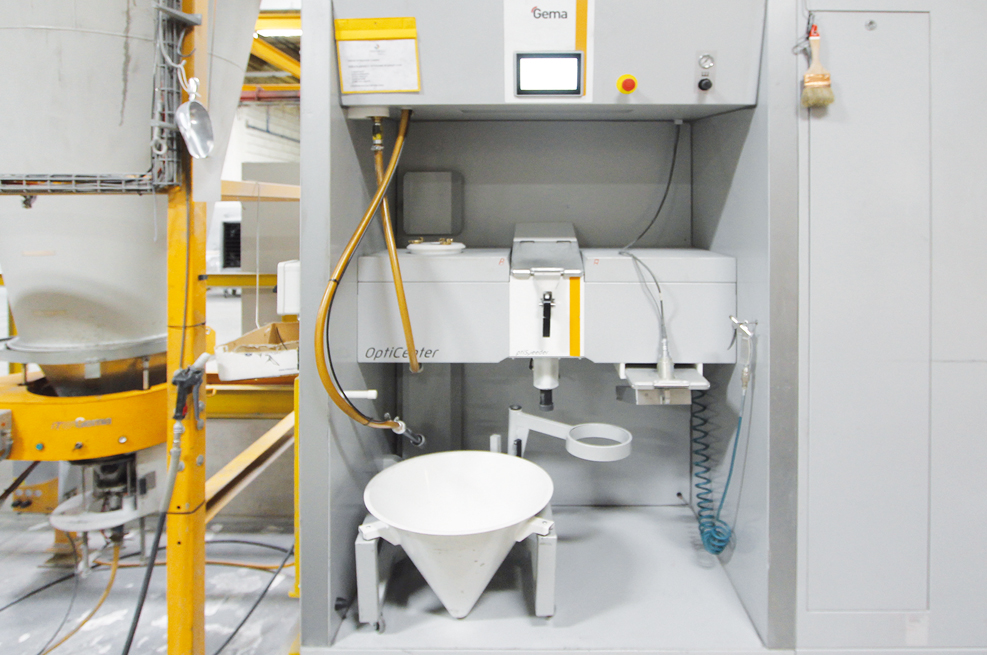 The powder centre. © ipcm
The powder centre. © ipcmConclusions
“Despite my initial scepticism about the three-year ROI guaranteed by Gema,” admits Alessandro Pintarelli, “I had to change my mind. For example, fire regulations for buildings are rapidly becoming stricter and stricter, such as EN 13381-8, which defines the maximum thickness applicable to steel sheets: if the thickness value exceeds it, the component is not compliant. Thanks to the new system installed by Gema, our guns can apply paint at the same distance and with the same flow rate even with calendered or concave sheet metal, which leads not only to better film distension and powder savings (currently 20%) but also to full control of paint application, which does not exceed the thickness parameters imposed by the standard.”
In future, Pintarelli Verniciature also expects an increase in its production capacity, as it will be less and less necessary to stop the conveyor to carry out manual touch-ups, which is also a significant advantage in terms of end results. “We are finding fewer and fewer paint defects due to human error, such as the orange peel effect, and we can provide products that are not only corrosion-resistant but also aesthetically pleasing, something that is also increasingly in demand in the architectural sector.”
Its far-sightedness and its ability to anticipate market needs and react quickly to customer demands have made Pintarelli Verniciature one of the best-known companies in the contract coating industry. “We were among the first to study and refine a process to obtain QUALISTEELCOAT certification, and this testifies to the attention to quality ingrained in our DNA, also evident when it comes to selecting devices and equipment for our factory – such as Gema Europe Srl’s Dynamic Contour Detection system.”
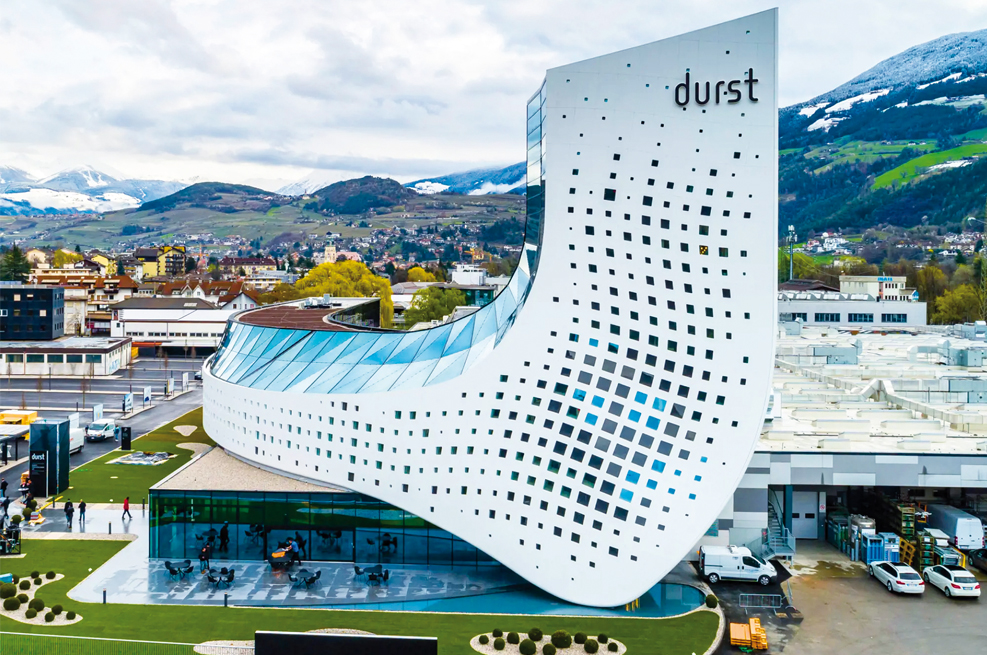 Durst’s headquarters in Brixen: in 2019, Pintarelli Verniciature powder-coated the aluminium components of its façade in compliance with the QUALICOAT certification standards. © Durst
Durst’s headquarters in Brixen: in 2019, Pintarelli Verniciature powder-coated the aluminium components of its façade in compliance with the QUALICOAT certification standards. © Durst